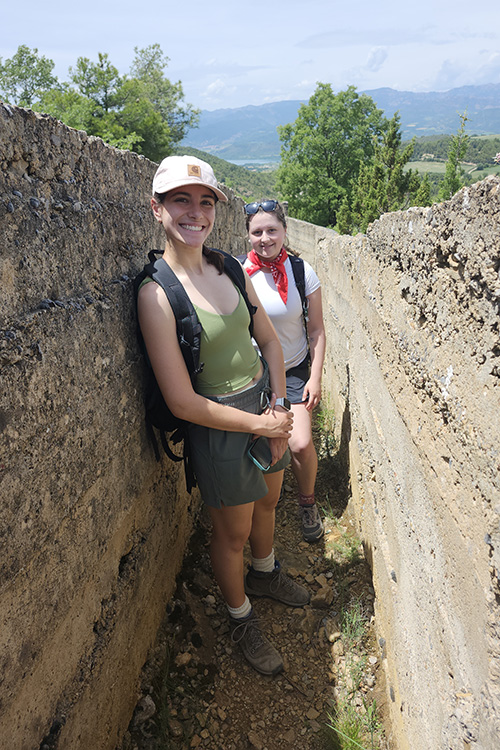- Apply
- Visit
- Request Info
- Give



Published on July 18, 2024
Two students from the Department of Environmental Earth Science (EES) at Eastern Connecticut State University joined Professor Peter Drzewiecki on a nine-day trip in the Pyrenees Mountains of Spain to examine the development of the area’s geological features in late May.
“The purpose of our trip was to collect data to confirm that small, curved faults, called listric faults, identified on Google Earth were actually submarine slumps and slides that moved large portions of Cretaceous reef facies downslope,” said Drzewiecki.
“These strata are older than the onset of convergence between the Iberian tectonic plate (Spain) and the European plate that created the Pyrenees, suggesting that salt tectonics preceded the Pyrenees Mountain building,” he said.
“Our work resolves longstanding questions about the early history of the Pyrenees that have been around since the area was first described in 1968.”

According to Drzewiecki, the excursion was a continuation of his ongoing research of the range’s gradual formation that had been put on hiatus following the COVID pandemic. The research conducted on the trip also benefitted EES major Hailey Cocca’s senior thesis, titled “Timing of Ancient Submarine Slumps and Structural Deformation in the Collades de les Basturs reef on the Sant Corneli Anticline; South-central Pyrenees, Spain.”
“While in Spain, we collected rock samples, measured sections and took attitude measurements to determine the angle of slumping, if any, to time the creation of the formation,” Cocca explained. “Being able to engage in hands-on research in such a beautiful region of Spain was an amazingly memorable experience that I will forever be grateful for.”
Senior EES major Emma Bean said that the trip enhanced her understanding of the classroom material and gave her a glimpse of the EES field’s various occupations.
“Many of the different geological features and fossils we saw in Spain were things I had learned about in the classroom before, but it’s a lot different when you’re actually in the field seeing everything,” said Bean. “I think that’s something the EES department does a great job with, whether it’s through class field trips or longer trips like this with opportunities to conduct research.”
In addition to seven total days of fieldwork, the trio enjoyed visiting some of Spain’s historic sites while trekking to remote research sites.
“We viewed the Roman walls at the town of Isona and explored the tiny village of Abelle de la Conca with its Romanesque church, Iglesia de Sant Esteve d'Abella de la Conca,” said Drzewiecki.
“The village also contains an excellent exposure of the Bóixols thrust fault. We spent the afternoon and evening at our actual field site getting familiar with the rocks,” he said. “On the way home we visited a dinosaur track site and climbed to the top of the Orcau Castle.”
“We also got to have one day to explore Barcelona,” said Bean. “The architecture in the city was amazing and nothing like I'd ever seen before.”
Drzewiecki explained that the trio’s immersion in Spain’s cultural history helped bring new perspectives to their scientific research.
“They were able to gain experience on how geological research is conducted: by recognizing a problem, determining how and where to best answer it and then going to the field to collect the data,” said Drzewiecki. “They were fortunate enough to be able to do so in an area with a long history and a rich culture.”
Written by Elisabeth Craig